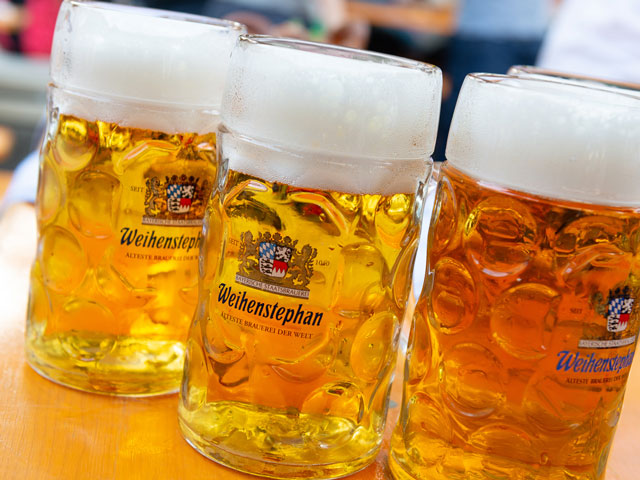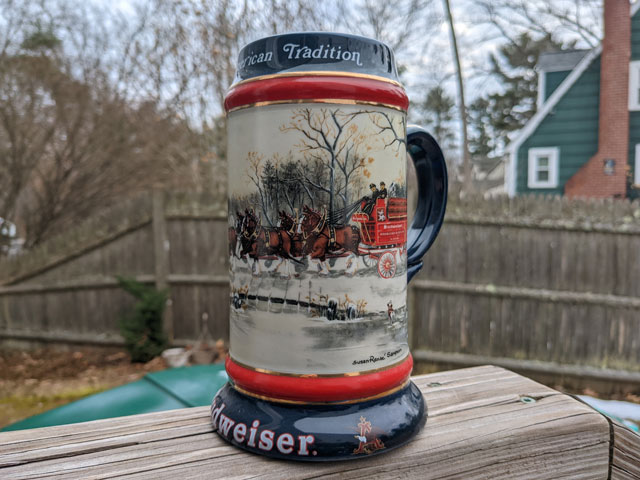A history of the Beer Stein. What are they? Where did they come from?
The time is the 15th century - the place, Germany. The bubonic plague and fly invasions have forced Germans to create laws requiring drink containers to be covered for sanitary purposes. At the same time, techniques for improving earthenware have resulted in the creation of stoneware. Alas, the stoneware beverage vessel with a pewter lid - also known as a beer stein - was born.
Written by CraftJack | Updated | 8 min read
Interesting Tools
- Beer BrüMate Hopsulator
- Brewing Northern Brewer Beer Making Kit
- Spirit Crystal Whiskey Glasses
- Wine Wine Decanter/Aerator

Now, these beer mugs are a popular symbol for both Germany and beer. They come in all kinds of shapes, sizes, and materials, including earthenware, metal, pewter, wood, ceramic, porcelain, crystal, creamware, silver, and glass. Most have handles, a hinged lid and are decorated or hand-painted.
The decorative elements of beer steins may represent traditional motifs, regalia, a coat of arms, or depict a person's occupation. Some are embellished with three-dimensional artwork and touch on a theme. You may also find a collectible series of beer steins with themed artwork or antique steins with engraved dates to commemorate a special occasion.
Beer steins come in a range of volumes, from one ounce to eight gallons. Steins most commonly fall in the 16.9-ounce range. They also making chugging beer really fun.
Idea: Someone should craft a stein that easily attaches to equipment or machinery. That way we could enjoy our lawnmower beer knowing it was securely in place.
Etymology of (Beer) Stein
Stein is a shortened version of the word steinzeug krug, which means stoneware, tankard, or jug in German. A stein is just one of many different types of beer glasses. The word transformed into staene in Old English and meant pitcher or jug. The most recognized English version, stein, appeared in 1855.
In common usage, stein refers to any beer container with a hinged lid and handle, although the word is often replaced with krug, seidel, or humpen in German. You may also come across people who use the word tankard to refer to only the all-silver and pewter steins.
History
The middle to late 14th century saw the Black Death kill more than 25 million Europeans. Even though this was a horrific event, it led to the progress of a civilization. There were many significant improvements made in various industries over the centuries. As you'll read, breweries and stein factories continued to increase production and improve on their products.
For fun, Weihenstephaner, the oldest brewery in the world, had already been around for a few hundred years at this point.
Early Steins: 1525 - 1700
As you read above, hoards of flies started invading central Europe in the late 1400s. The fly invasion, combined with the bubonic plague, resulted in Germany passing sanitary laws that required all food and beverage containers to have coverage to protect the public from the insects.
Mugs, drink containers with a handle but no lid, were commonly used during this time. But once the sanitary laws passed, these mugs needed coverage, so some clever people invented the hinged lid with a thumblift. This invention ensured the mug stayed covered but could also be used to drink out of using only one hand (hence the convenient thumblift).
Once the 1500s rolled around, regulations regarding the quality and transportation of German beer resulted in better tasting beer and a variety of steins. Historical records show that the average beer consumed on a daily basis increased to around two liters. As you can imagine, beerhouses and taverns grew in popularity during this time. And along with their new and improved beer, Germans desired a personal tankard they could be proud to show off.
As other parts of Europe were still brewing their beer using eggs, cabbage, and moldy bread, the fresh brews coming out of Germany proliferated, and people began exporting them throughout Europe. People also wanted durable but inexpensive containers to drink their clean beer out of. This gave rise to scientists and artisans hunting for the best materials.
They didn't have to look too far, as they were already familiar with earthenware. They only had to improve it by experimenting with firing techniques. Eventually, stoneware was created and proved to be a superior material that was chip-resistant and non-porous. It was the perfect component for a container that needed to meet sanitary conditions.
Soon after, artisans began decorating tankards with scenes depicting towns throughout southern and Western Germany, like Heidelberg and Rothenburg. They also created artistic scenes that captured biblical, allegorical, and historical moments.
Transition Period: 1700 - 1850
The covered-container laws ceased to exist by the late 1800s, but because the Germans were taught to cover their beverages for over 300 years, the stein was seen as incomplete without a lid.
The 18th-century trends continued to rise in popularity. The Bavarians had over 4000 breweries, and stoneware production increased into the late 1700s.
European porcelain started impacting stein-making in the 1720s, but the products were expensive, and only wealthy Germans could afford to drink beer out of porcelain and glass tankards.
Just as steins improved, so did the beer, and it eventually became an essential beverage. In fact, from the early days and into the 1800s, most people considered beer to be an effective medicine, as it was seen to induce health and relaxation. It was also safer to drink beer than water due to its sanitary production process.
At the end of the Baroque period (circa 1800), pewter and silver steins were still obscure in Germany but proliferated in England. The English put a certain finesse on their lidded mugs. One could still find a ceramic stein, but many factories at the time began making only pewter and silver tankards.
A significant transition from Baroque extravagance to functional folk art transpired after the 1800s. Wars and rebellions decreased the wealth and power the aristocrats once had, so stein makers began looking to the middle class as their target market and made products to fit their lifestyles.
Cylindrical pewter steins became popular, and especially those with stamped or engraved folk art designs. The wealthy still preferred porcelain beer steins with Baroque flair. By the early 1800s, the general population preferred glass and pewter, leading stoneware manufacturers to create items like bowls, jars, and jugs.
The Golden Era: 1850 - 1910
By 1850, Neo-Renaissance and Neoclassical art forms took hold, and students were instructed to adapt the designs from the Renaissance and Classical periods primarily. Beer steins featured Renaissance motifs and relief decorations. They also had inlaid porcelain lids.
Stoneware had a resurgence after 1850. Makers used molds instead of the expensive and labor-intensive original manufacturing process. Although more affordable and convenient, the molded tankards were no longer considered authentic German beer steins, as they were being mass-produced.
Fun fact: Helium was discovered in 1868. Do you think anyone tried to make helium beer back then?
Anyway, glass-making techniques progressed during the second half of the 1800s, which allowed molds to be used to produce glass steins. Glassmakers quickly learned tricks to amplify sales, including producing multi-colored glass and pewter overlays, staining, and acid etching.
Moisture-absorbing plaster molds helped porcelain stein producers make unique shapes and the lithophane scenes that are commonly found on the bottom of porcelain steins.
Classically trained artists from the Mettlach factory introduced Renaissance motifs into their line of relief steins. They experimented with clay and glazes, which led to colorful mosaic and etched beer steins. Society loved these beautiful creations so much that even the lowly laborers were willing to spend their week's pay on one of these products.
The 1900s saw a decrease in Classical designs. Instead, people favored scenes depicting towns, social scenes, military commemoratives, and occupational emblems. These kinds of motifs felt more common but personal to the individual. To meet the demands, pottery makers entered the scene and started making stoneware and glazed pottery beer steins.
The newest art style, Art Nouveau, grew a small but dedicated audience in early 1900, but by 1910, the political and economic landscape turned the stein-making industry upside down. World War I demanded that the materials used to make beer steins be converted for ammunition production. With no material or labor force, stein-making came to a halt.

The Modern Period: 1920 - Present
Stoneware, porcelain, and glass stein production increased during the 1920s. Economic and political turmoil did slow down stein manufacturing during the 1930 and 40s, but aside from those time periods, factories have continued to produce a vast amount of beer steins to this day.
The modern art period owes some of its popularity to Classical and Renaissance art. During the period between 1840 and 1900, public museums were opened, and everyone, not just high society or art intellectuals, enjoyed artistic masterpieces.
Renaissance steins were seen as artwork, and people appreciated the antique beauty and artistic quality these products offered. Museums began collecting steins, which led to their increase in popularity.
Antique steins have shaped and influenced stein manufacturing in modern times. Between 1900 and 1920, quality beer stein reproductions were created, most made of pewter and faience.
These early reproductions were marked so that antique stein collectors wouldn't be fooled. However, there are some unmarked reproductions of early pewter and Renaissance stoneware tankards available on the market. One must have a scrutinizing eye to determine their authenticity. Since the 1960s and 70s, some types of antique steins have received values high enough for manufacturers to consider reproducing their products solely to deceive collectors.
Over the last 40 years, many changes have shaped stein production. For instance, after World War II, stein production moved toward relief pottery, and America became one of the primary markets for new beer steins. Limited editions are especially popular within this primary market.
Additionally, Ceramarte of Brazil entered the market in the early 1970s and quickly became one of the world's largest producers of beer steins.
Material
Beer steins were generally made from pewter in most European areas, specifically England, but manufacturers also produced steins from silver, glass, and porcelain. You can find beer steins made out of earthenware, crystal, and wood, as well.
From the introduction of glass tankards to the first Oktoberfest and beyond, the common German beer steins are usually made from glass for hygienic purposes. Most versions, aside from luxury and antiques, do not have a lid.
There have been attempts to replace glass and earthenware beer mugs with plastic versions, mainly due to security reasons, but these attempts are typically met with contempt. In one instance, people burned the plastic mugs in protest. Needless to say, the transition to plastic beer steins has never been successful, either temporarily or in the long run in Germany.
Lids
Beer stein lids served as a sanitary measure across history and were generally made from pewter and equipped with a thumblift - a lever that the thumb can easily reach and flip to open the lid.
Stein lids are also an important factor when determining what a stein's age, quality, and price are. Lids can be put into several categories, including:
- Conical Lids: The least expensive lid, commonly shaped like a cone or steeple.
- Flat Lids: A lid with a flat surface that's typically made of pewter and can be easily engraved.
- Inlay Lids: This lid features a pewter rim and lip (flange) and a stoneware figurine or ornamental design inlaid in the middle of the lid. Inserts are generally made of porcelain, glass, and wood.
- Ornamental Lids: These models are always made of pewter and are the most popular style for limited edition beer steins. They are conical in shape, feature detailed handwork, and display a finial or common design at the top.
- Stoneware Lids: A simple lid made of stoneware that's held in place by pewter fittings.
Although beautiful in design and construction (and a perfect solution in the early days), beer stein lids aren't commonplace any longer. When needed, modern beer drinkers tend to use beer mats to cover their beer glasses and mugs.
Alternatives to the Beer Stein
- Beer Mug
- Nonic Pint Glass
- Pilsner Glass
Conclusion
Although such a simple item, the beer stein has a long and rich history. What we know as the common beer stein has been around since the early 1400s. Thanks to a horrific plague and a legion of dirty insects, this every day handled beer mug became not only a personal drinking vessel but a work of art for many people.
From the early stoneware pieces with intricate designs and hinged lids to the classically-influenced modern era of steins, these beloved beer containers have traversed the globe and continued to persevere in production.
Whether you're an avid collector of antique beer steins or just curious about where these vessels got their name from, I hope this article has served you well in learning about the history and production of steinzeug krugs.
